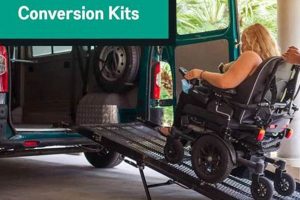A device or collection of components designed for home use to remove air bubbles from a vehicle’s hydraulic braking system is fundamentally what we’re dealing with. This typically involves a system of hoses, a reservoir, and potentially a vacuum or pressure source to facilitate the flow of brake fluid and expel trapped air. These systems vary in complexity, from simple one-way valve setups to more elaborate vacuum pump-driven apparatuses.
The significance lies in the ability to maintain optimal brake performance. Air in the brake lines compromises hydraulic pressure, leading to a spongy brake pedal feel and reduced stopping power. Historically, brake bleeding required two people. These kits empower a single individual to perform this essential maintenance task, saving on potential mechanic fees and ensuring timely upkeep, which contributes to vehicle safety and longevity.
The following sections will delve into the types available, considerations for selection, the process of use, and essential safety precautions associated with brake bleeding systems designed for amateur mechanics and car enthusiasts.
Essential Usage Tips for Brake Bleeding Devices
Optimizing performance and ensuring safety are paramount when employing a home-based brake bleeding system. The subsequent recommendations offer guidance for effective and secure operation.
Tip 1: Select the Appropriate Kit. Determine the specific vehicle’s brake system requirements before purchase. Some systems are better suited for certain vehicle types or brake configurations. Verify compatibility to avoid potential damage or ineffective bleeding.
Tip 2: Prioritize Safety Equipment. Always wear eye protection and chemical-resistant gloves. Brake fluid is corrosive and can cause irritation or damage to skin and eyes. Proper personal protective equipment is a non-negotiable prerequisite.
Tip 3: Use the Correct Brake Fluid. Consult the vehicle’s owner’s manual to identify the recommended brake fluid type (DOT 3, DOT 4, DOT 5.1, etc.). Using the incorrect fluid can compromise braking performance and potentially damage the brake system’s seals and components.
Tip 4: Thoroughly Clean Bleeder Screws. Before initiating the bleeding process, clean the bleeder screws on each brake caliper or wheel cylinder. Dirt and debris can prevent a proper seal, leading to air re-entering the system. Consider using a wire brush and brake cleaner.
Tip 5: Maintain Consistent Fluid Levels. Monitor the brake fluid reservoir throughout the bleeding process. Never allow the reservoir to empty completely, as this will introduce more air into the system, necessitating a re-bleed. Regularly top off the fluid to maintain an adequate level.
Tip 6: Follow a Systematic Bleeding Sequence. Consult the vehicle’s repair manual for the recommended bleeding sequence. Typically, one begins with the brake furthest from the master cylinder and proceeds progressively closer. Adhering to the prescribed sequence maximizes efficiency.
Tip 7: Properly Dispose of Used Brake Fluid. Used brake fluid is a hazardous waste product and must be disposed of responsibly. Consult local regulations for approved disposal methods. Never pour brake fluid down drains or onto the ground.
Consistent and conscientious application of these tips can enhance the effectiveness of the device and, most importantly, contribute to driving safety. Attention to detail during each step is crucial for achieving optimal brake performance.
The subsequent section will explore the maintenance and long-term storage requirements to preserve the integrity of the device for future applications.
1. Compatibility
The functionality of a home-based brake bleeding system hinges directly on its compatibility with the target vehicle’s braking system. Mismatched components, particularly the bleeder screw adapters, render the entire kit ineffective. Incompatible adapters fail to create a secure, air-tight seal on the bleeder screw, preventing proper fluid extraction and potentially introducing air into the hydraulic lines. This renders the entire bleeding process futile, negating any potential improvements in braking performance.
Consider, for example, a scenario where a user attempts to employ a kit designed for Japanese vehicles (typically featuring metric bleeder screw sizes) on an older American vehicle (often utilizing imperial sizes). The resulting loose fit prevents vacuum or pressure from being properly applied to the system, resulting in fluid leakage and continued spongy brake feel. Similarly, the threads of an incompatible adapter could strip the bleeder screw, necessitating costly repairs. The correct adapter size and thread pitch are paramount to ensuring a proper connection and preventing damage.
Therefore, thorough research into vehicle-specific bleeder screw dimensions and brake system configurations is crucial prior to selecting a brake bleeding system. Verification of compatibility avoids wasted expense, prevents damage to vehicle components, and ultimately ensures the system can perform its intended function: the removal of air from the brake lines and the restoration of optimal braking performance. The user’s safety and the integrity of the vehicle’s braking system are directly dependent on this fundamental aspect of compatibility.
2. Ease of Use
The practicality of a brake bleeding device for home use is significantly determined by its operational simplicity. Intricate or cumbersome designs can deter infrequent users and potentially lead to errors, compromising the effectiveness of the brake bleeding procedure.
- Intuitive Assembly and Setup
The initial setup should not require specialized tools or extensive technical knowledge. Clearly labeled components and straightforward instructions are essential. Complex assembly processes increase the likelihood of incorrect configuration, potentially rendering the kit ineffective or even causing damage to the vehicles brake system. A system that can be readily assembled and connected promotes confident and safe operation.
- Single-Person Operation
Traditional brake bleeding often requires two individuals: one to operate the brake pedal and another to open and close the bleeder screws. Kits designed for single-person operation eliminate this requirement through integrated vacuum or pressure systems. The ability to perform the entire process independently increases accessibility and convenience, encouraging more frequent maintenance.
- Clear Monitoring of Fluid Levels
The reservoir and tubing should allow for easy observation of brake fluid levels and the presence of air bubbles. Opaque or poorly designed systems obscure the visual confirmation of successful air removal, potentially leading to incomplete bleeding and compromised braking performance. Transparency and unobs
tructed visibility are critical features. - Simple and Secure Connection Mechanisms
Connecting the device to the vehicle’s bleeder screws should be a simple and secure process, minimizing the risk of leaks or disconnections during operation. Quick-connect fittings and robust clamping mechanisms contribute to ease of use and prevent interruptions. Fumbling with loose connections or struggling to maintain a seal detracts from the overall user experience and increases the potential for error.
Ultimately, a user-friendly is designed to empower vehicle owners to perform a critical maintenance task effectively and safely. Simplicity in design and operation fosters confidence, encourages regular maintenance, and contributes to improved vehicle safety. A kit that is difficult or frustrating to use is less likely to be employed consistently, negating its intended benefits.
3. Air-Tight Seal
The effectiveness of any brake bleeding system is fundamentally predicated on the integrity of its air-tight seal. This pertains to all connections within the apparatus, most critically the interface between the system’s adapter and the vehicle’s bleeder screw. Compromises to this seal directly undermine the kit’s intended function, rendering it incapable of properly evacuating air from the hydraulic brake lines. Without a positive seal, atmospheric air is drawn into the system during operation, counteracting the creation of a vacuum or the maintenance of positive pressure intended to facilitate fluid flow and air expulsion. This phenomenon effectively recirculates air within the braking system, perpetuating the initial problem and potentially exacerbating it. A defective seal manifests as continuous air bubbles during the bleeding process, failure to achieve a firm brake pedal, and ultimately, diminished braking performance.
Consider the instance where a brake bleeding kit utilizes rubber hoses and plastic fittings that degrade over time or are not properly tightened. The resultant microscopic gaps allow air infiltration, negating the vacuum created by the system’s pump. Similarly, if the adapter designed to mate with the bleeder screw lacks precise machining or suffers damage, a secure connection is impossible. The consequence is the same: air is drawn in through the imperfect seal, sabotaging the process. Even slight imperfections in the seal compromise the hydraulic integrity, requiring repeated attempts and potentially rendering the kit unusable. The quality of materials, precision of manufacturing, and proper maintenance of the system’s components directly influence the reliability of the air-tight seal and, consequently, the kit’s overall performance.
In summary, the air-tight seal represents a critical vulnerability point for any brake bleeding apparatus. Its failure negates the kit’s utility, compromises braking performance, and potentially jeopardizes vehicle safety. The selection of kits constructed from durable materials, featuring precision-engineered fittings, and adhering to rigorous quality control standards is paramount. Routine inspection and proper maintenance of the seals and connections are essential to ensuring the continued effectiveness of the brake bleeding system and the integrity of the vehicle’s braking performance.
4. Durability
The longevity and sustained performance of a apparatus for hydraulic brake maintenance are directly linked to its inherent constructional robustness. Material selection and manufacturing quality dictate the ability to withstand repeated use, exposure to corrosive brake fluids, and the rigors of a garage environment. A lack of durability translates to frequent replacements, increased operational costs, and potentially compromised safety.
- Material Resistance to Brake Fluid
The constituent components, particularly hoses, seals, and reservoirs, must exhibit a high degree of resistance to the chemical properties of brake fluid. Prolonged exposure can degrade less resistant materials, leading to leaks, embrittlement, and eventual failure. Kits employing materials such as EPDM rubber, Viton, or high-density polyethylene offer superior resistance compared to those utilizing standard rubber or low-grade plastics. The selection of chemically inert materials ensures the integrity of the system over extended periods.
- Mechanical Robustness of Components
Fittings, adapters, and the pump mechanism (if applicable) must withstand repeated connection/disconnection cycles and the application of pressure or vacuum without deformation or breakage. Components constructed from brass, stainless steel, or reinforced composites offer superior mechanical strength compared to those made from flimsy plastics or soft metals. Robust construction ensures a secure and reliable seal, preventing leaks and maintaining the efficiency of the bleeding process.
- Resistance to Environmental Factors
A brake bleeding device stored in a garage environment is subject to temperature fluctuations, humidity, and potential exposure to other chemicals and contaminants. Durable kits are constructed from materials that resist degradation under these conditions, preventing cracking, warping, or corrosion. Proper storage and maintenance contribute to the longevity of the kit, but the inherent material properties are paramount in withstanding environmental stressors.
- Longevity of Seals and Valves
Seals and valves are critical components for maintaining pressure or vacuum within the apparatus. Their durability is paramount to preventing leaks and ensuring proper operation. High-quality seals made from resilient materials that resist wear and tear contribute significantly to the overall lifespan. Similarly, durable valve mechanisms are essential for precise control and reliable performance over repeated use. Premature failure of seals or valves renders the kit ineffective.
The selection of a kit with robust construction and chemically resistant components represents a long-term investment in vehicle maintenance. While lower-priced options may seem appealing initially, the increased likelihood of premature failure necessitates more frequent replacements, ultimately increasing the overall cost of ownership. Prioritizing durability ensures a reliable and safe means of maintaining optimal braking performance.
5. Fluid Capacity
The fluid capacity of a reservoir directly impacts the efficacy of the brake bleeding process. Insufficient capacity necessitates frequent refilling, increasing the risk of introducing air into the master cylinder. Air ingestion negates the bleeding effort, requiring repetition and potentially compromising the brake system. Conversely, excessively large reservoirs may be unwieldy, but pose no functional detriment unless they interfere with access or stability during the maintenance procedure. An appropriately sized reservoir, therefore, minimizes interruptions and enhances the likelihood of a successful, single-attempt bleed.
For example, consider two scenarios. In the first, a vehicle with a substantial brake system volume requires a full fluid flush. A system with a small reservoir demands multiple refills, creating opportunities for air to en
ter the master cylinder. The user must diligently monitor the level, potentially leading to fluid spillage or inadvertent air intake. In the second scenario, a kit with an adequate reservoir allows for the complete fluid exchange without interruption, streamlining the process and minimizing the risk of complications. The difference lies in the ability to maintain a consistent fluid supply, thereby preventing air from entering the system at the source.
In summary, fluid capacity is a critical design consideration. The optimal volume balances the need for uninterrupted fluid replacement with practical handling considerations. Selecting a kit with an appropriate reservoir size, aligned with the vehicle’s brake system demands, simplifies the bleeding process and improves the likelihood of achieving a firm and reliable brake pedal. The user should consult the vehicle’s service manual to estimate total system volume and select a device with corresponding capacity, plus a reasonable margin for safe operation.
Frequently Asked Questions
The following addresses common inquiries regarding the safe and effective utilization of home-based brake bleeding systems. The information provided is intended to clarify proper procedures and mitigate potential risks.
Question 1: What is the primary function of a brake bleeding apparatus?
The principal function is to remove entrapped air from the hydraulic brake lines. Air compressibility diminishes braking efficiency, resulting in a spongy pedal feel and reduced stopping power. The tool facilitates the expulsion of air, restoring optimal hydraulic pressure.
Question 2: Is a system mandatory for effective brake bleeding?
While not strictly mandatory, a bleeding device significantly simplifies the process, especially for single-person operation. Traditional methods often require two individuals, whereas a system enables independent completion of the task.
Question 3: What are the key safety precautions to observe during brake bleeding?
Eye protection and chemical-resistant gloves are essential to prevent injury from corrosive brake fluid. The vehicle should be properly supported to prevent accidental movement. Used brake fluid must be disposed of responsibly, according to local regulations.
Question 4: How frequently should brake bleeding be performed?
The recommended interval varies depending on the vehicle manufacturer’s specifications and driving conditions. Typically, brake bleeding is advised every two to three years, or whenever the brake fluid appears contaminated or the pedal feels spongy.
Question 5: What type of brake fluid is compatible with a particular braking system?
The vehicle’s owner’s manual specifies the correct brake fluid type (DOT 3, DOT 4, DOT 5.1, etc.). Using an incompatible fluid can damage seals and compromise braking performance. Always adhere to the manufacturer’s recommendations.
Question 6: What are signs that brake bleeding is necessary?
Common indicators include a spongy or soft brake pedal, reduced stopping power, and extended braking distances. Visual inspection may reveal discolored or contaminated brake fluid, further suggesting the need for bleeding and fluid replacement.
In summary, a provides a convenient means of maintaining optimal braking performance. Adherence to safety guidelines and proper procedures is paramount for ensuring effective and safe operation.
The subsequent section will explore advanced techniques and troubleshooting tips for resolving common issues encountered during brake bleeding.
Conclusion
The preceding discussion has explored the multifaceted aspects of the diy brake bleeder kit. From its fundamental function in removing air from hydraulic brake lines to the critical considerations of compatibility, ease of use, air-tight seals, durability, and fluid capacity, the analysis reveals the importance of informed selection and proper application. The information provided aims to empower vehicle owners with the knowledge necessary to perform essential brake maintenance safely and effectively.
Effective employment of a diy brake bleeder kit, guided by the principles outlined, contributes directly to vehicle safety and performance. Consistent maintenance, utilizing appropriate tools and techniques, ensures reliable braking and protects against potential hazards. Prioritizing safety and adhering to recommended procedures are paramount for achieving optimal results and preserving the integrity of the vehicle’s braking system for the long term.







